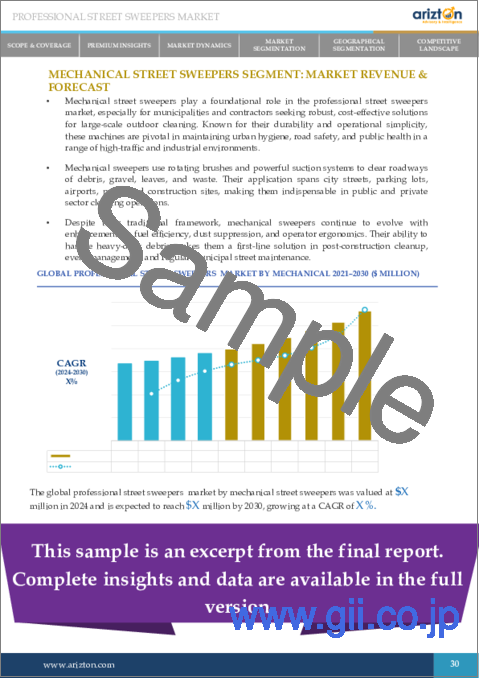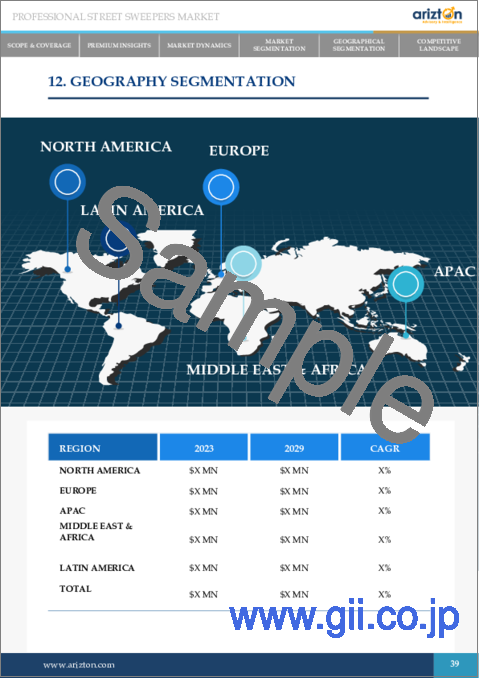|
|
市場調査レポート
商品コード
1718881
業務用路面清掃車の世界市場:2021-2030年Global Professional Street Sweepers Market Research Report 2021-2030 |
||||||
|
|||||||
| 業務用路面清掃車の世界市場:2021-2030年 |
|
出版日: 2025年05月02日
発行: Arizton Advisory & Intelligence
ページ情報: 英文 185 Pages
納期: 即納可能
|
全表示
- 概要
- 目次
世界の業務用路面清掃車の市場規模は、2024年から2030年にかけてCAGR 6.06%で成長すると予測されています。
市場動向と促進要因
電気式およびハイブリッド式清掃車の採用
電動式およびハイブリッド式の路面清掃車への移行は、業務用清掃車市場における重要な動向となっています。世界的に二酸化炭素排出削減と持続可能な目標の達成が求められる中で、自治体や民間企業は環境に配慮した清掃ソリューションへの投資を増やしています。再充電可能なバッテリーで動く電動清掃車は、排出ガスゼロかつ騒音も少ないため、環境への配慮が求められる都市部に最適です。ハイブリッド式清掃車は、従来の内燃機関と電動モーターを組み合わせることで、パワーと効率のバランスを取りつつ、長時間の稼働や燃料消費の削減を可能にします。さらに、環境対応技術への政府の助成金や補助金制度の充実が、こうした先進的な清掃車の導入を加速させています。
アジアの製造業の台頭
アジアの製造業が同市場に与える影響は、アジアの市場シェアの拡大によって明らかになっています。業界レポートによると、アジア太平洋地域は急速な都市化、経済発展、そして環境持続可能性への関心の高まりを背景に、業務用路面清掃車市場において大きな成長が見込まれています。特に中国とインドが成長を牽引しており、効率的な路面清掃ソリューションを必要とする都市インフラやスマートシティプロジェクトへの多額の投資が進んでいます。アジアの製造業者は国内市場に加えて、コストパフォーマンスに優れた高性能清掃車を国際市場にも提供しており、その存在感を高めています。西洋諸国の製造業者に比べて低コストで先進的な清掃車器を製造できることが、競争優位性を生んでいます。このようなグローバル展開は、都市清掃ニーズに対応するために先進的なソリューションを採用する地域が増えることで、路面清掃車市場全体の成長にも貢献しています。
環境持続性への注目の高まり
環境持続可能性は、多くの自治体や企業の重要課題となっており、環境負荷を最小限に抑える業務用路面清掃車の需要を後押ししています。粉じん抑制機能や節水機能が強化された清掃車は、清掃中の粉じんの拡散や水の使用量を抑えるため、特に人気があります。さらに、環境に優しい生分解性の洗浄剤の開発も進んでおり、清掃作業が自然環境に悪影響を与えないよう配慮されています。このような動きは、排出基準や持続可能性目標への適合が重視される欧州や北米など、環境規制が厳しい地域で特に顕著です。
都市化とインフラ開発
急速な都市化と継続的なインフラ開発プロジェクトも同市場の成長を促進しています。都市の拡大や新たな道路、高速道路、公的スペースの建設が進むにつれ、清潔さや公衆衛生基準を維持するために、効率的かつ信頼性の高い清掃ソリューションの需要が高まっています。特に都市の成長が著しいアジア太平洋地域では、近代的なインフラへの投資と並行して、都市生活における課題を解決するために先進的な路面清掃技術の導入が進められています。この流れは、都市インフラや環境の質を向上させることを目的とした政府の施策や資金提供によってさらに後押しされています。
当レポートでは、世界の業務用路面清掃車の市場を調査し、市場概要、市場への各種影響因子の分析、市場規模の推移・予測、各種区分・地域/主要国別の詳細分析、競合情勢、主要企業のプロファイルなどをまとめています。
主要企業プロファイル
- Tennant Company
- Alfred Karcher SE & Co. KG
- Global Environmental Products, Inc.
- Bucher Municipal
- Fayat Group
- Aebi Schmidt Group
- Piquersa Maquinaria, S.A.
- Nilfisk A/S
- Hako Machines Ltd
- Ceksan Sweepers
- Schwarze Industries
その他の有力企業のプロファイル
- Alamo Group Inc.
- Fulongma Group Co., Ltd.
- TYMCO, Inc.
- Madvac
- Dulevo International S.p.A.
- Eureka
- FAUN Umwelttechnik GmbH & Co. KG
- Green Machines International B.V.
- Chengli Special Automobile Co., Ltd.
- Zhengzhou Dongfeng Mid-South Enterprise Co., Ltd.
- OMM Lavapavimenti
- PowerBoss
- Cleanland (Tirth Hygiene Technology Pvt. Ltd.)
- Broce Broom
- Victory Sweepers
- Curbtender Sweepers
- Sajas Group
- FCC Group
- NiteHawk Sweepers
- Boschung
製品タイプ区分
- 機械式清掃車
- 再生空気式清掃車
- 真空式清掃車
- ロボットおよび自動清掃車
- 高効率無粉じん清掃車
- 乾式清掃車
- その他
容量区分
- 小容量
- 中容量
- 大容量
- その他
電源区分
- 電気式清掃車
- ガス式清掃車
- ハイブリッド式清掃車
- 水素燃料電池式清掃車
- その他
エンドユーザー区分
- 商業スペース
- 自治体・市役所
- 産業施設
- その他
地域区分
- 北米
- 米国
- カナダ
- 欧州
- ドイツ
- フランス
- ロシア
- 英国
- ノルウェー
- デンマーク
- イタリア
- ポーランド
- スペイン
- アジア太平洋
- 中国
- インド
- 日本
- 韓国
- オーストラリア
- インドネシア
- マレーシア
- ラテンアメリカ
- ブラジル
- アルゼンチン
- メキシコ
- 中東・アフリカ
- サウジアラビア
- UAE
- 南アフリカ
目次
第1章 調査範囲
第2章 重要考察
- チャンスポケット
- 主要市場ハイライト
- 地域別洞察
第3章 市場力学
- 機会と動向
- 市場促進要因
- 市場抑制要因
- 市場情勢
第4章 市場セグメンテーション
- 製品タイプ別
- 容量タイプ別
- 電源別
- エンドユーザー別
第5章 地域別市場
- アジア太平洋
- 北米
- 欧州
- ラテンアメリカ
- 中東・アフリカ
第6章 競合情勢
- 競合シナリオ
- 市場シェア分析
- 主要企業のプロファイル
- その他の有力企業のプロファイル
The global professional street sweeper market is expected to grow at a CAGR of 6.06% from 2024 to 2030.
MARKET TRENDS & DRIVERS
Adoption of Electric and Hybrid Sweepers
The transition to electric and hybrid-powered street sweepers is a significant trend in the professional street sweeper market. With the global push toward reducing carbon emissions and achieving sustainability goals, municipalities and private companies have increasingly invested in eco-friendly street cleaning solutions. Electric sweepers, powered by rechargeable batteries, offer the advantage of zero emissions and reduced noise pollution, making them ideal for urban areas sensitive to environmental concerns. Hybrid sweepers combine traditional internal combustion engines with electric motors, balancing power and efficiency, enabling extended operational hours and lower fuel consumption. The growing availability of government incentives and subsidies for green technologies further accelerates the adoption of these advanced sweepers.
Growing Prominence of Asian Manufacturing
The impact of Asian manufacturing on the professional street sweeper market is evident in the region's increasing global market share. According to industry reports, Asia-Pacific is expected to witness significant growth in the professional street sweeper market, driven by the region's rapid urbanization, economic development, and increasing focus on environmental sustainability. China and India are leading this growth, with substantial investments in urban infrastructure and smart city projects that require efficient street cleaning solutions. In addition to the domestic market, Asian manufacturers made inroads into international markets, offering cost-effective, high-performance street sweepers. Their ability to produce advanced street cleaning equipment at lower costs than their Western counterparts gives them a competitive edge. This global expansion contributes to the overall growth of the professional street sweepers market as more regions adopt these advanced solutions to address their urban cleaning needs.
The growing prominence of Asian manufacturing plays a pivotal role in expanding the professional street sweeper market. The region's manufacturing prowess, rapid urbanization, technological advances, and strategic partnerships drive the demand for professional street sweepers domestically and globally. As Asian manufacturers continue to innovate and expand their market presence, they are set to play an increasingly influential role in shaping the future of the professional street sweepers market.
Increased Focus on Environmental Sustainability
Environmental sustainability is at the forefront of many municipal and corporate agendas, driving demand for street sweepers that minimize environmental impact. Sweepers with enhanced dust control and water conservation features are more popular, as they help reduce airborne particles and water usage during cleaning operations. In addition, the development of biodegradable and environmentally friendly cleaning agents has gained traction, ensuring that street cleaning practices do not harm the environment. This trend is firm in regions with stringent environmental regulations, such as Europe and North America, where compliance with emission standards and sustainability goals is paramount.
Urbanization and Infrastructure Development
Rapid urbanization and ongoing infrastructure development projects, particularly in emerging economies, drive the growth of the professional street sweeper market. As cities expand and new roads, highways, and public spaces are constructed, there is an increasing need for efficient and reliable street cleaning solutions to maintain cleanliness and public health standards. In Asia-Pacific, where urban growth is particularly pronounced, investments in modern infrastructure are coupled with the adoption of advanced street cleaning technologies to manage the challenges of urban living. This trend is supported by government initiatives and funding to improve urban infrastructure and environmental quality.
SEGMENTATION INSIGHTS
INSIGHTS BY PRODUCT TYPE
In the global professional street sweeper market, the mechanical street sweepers segment is anticipated to be the leading revenue contributor among product types, reflecting a robust compound annual growth rate (CAGR) of 6.89% during the forecast period. Its effectiveness, versatility, and long-standing use in various applications drive this segment's prominence. Mechanical street sweepers are renowned for their robust performance and reliability in street cleaning operations. These sweepers utilize mechanical brushes and brooms to remove debris, dirt, and litter from surfaces effectively. Their design ensures that they can handle various types of waste, from fine dust to larger pieces of debris. The proven effectiveness of mechanical sweepers in maintaining cleanliness on urban streets, highways, and parking lots has solidified their position as a preferred choice for municipalities and commercial entities.
- Mechanical sweepers efficiently clean large areas and can handle significant volumes of debris, making them suitable for busy urban environments and industrial sites.
- Modern mechanical sweepers feature improved brush designs, increasing cleaning efficiency and reducing maintenance needs. Enhanced brush materials and configurations allow for better debris collection and surface cleaning.
- Newer models of mechanical sweepers are equipped with advanced control systems that make them easier to operate. User-friendly interfaces and automated features improve operational efficiency and reduce the training required for operators.
- Mechanical sweepers are designed to withstand harsh operating conditions, ensuring long-term reliability and reduced maintenance needs built with heavy-duty components.
The mechanical street sweepers segment is set to lead the global market due to their proven effectiveness, versatility, and technological advances. Regional demand for reliable and cost-effective cleaning solutions, combined with ongoing innovations, supports mechanical sweepers' continued growth and dominance in the professional street sweeper market.
INSIGHTS BY CAPACITY TYPE
The global professional street sweeper market by capacity is segmented into small hopper capacity, medium hopper capacity, large hopper capacity, and others. In the market, the small hopper capacity sweepers segment is expected to emerge as the leading revenue contributor among capacity types. This segment's growth is driven by its suitability for specific applications, technological advances, and evolving market demands. Small hopper capacity sweepers are particularly well-suited for urban areas and spaces with limited accessibility. Their compact size and maneuverability make them ideal for cleaning narrow streets, pedestrian zones, parking lots, and other confined areas. In densely populated cities, where space is at a premium, these sweepers offer an efficient solution for maintaining cleanliness without causing disruptions to traffic or pedestrian flow. Municipalities and commercial establishments, such as shopping malls, office complexes, and educational institutions, are major consumers of small hopper capacity sweepers. These sectors require regular and efficient cleaning to maintain hygiene standards and public health. The ability of small hopper sweepers to operate in various environments, including sidewalks, plazas, and courtyards, makes them a preferred choice for these applications. The increasing focus on urban beautification and the need to manage waste in public spaces further drive the demand for these sweepers.
INSIGHTS BY POWER SOURCE
In the global professional street sweeper market, the electric-powered sweepers segment is projected to be the leading revenue contributor among power source types, with anticipated growth to USD 1.40 billion by 2030. This significant rise can be attributed to regional trends and technological advances transforming the market landscape. Across regions, such as North America and Europe, stringent environmental regulations and policies push for cleaner and more sustainable solutions. Electric-powered sweepers, which produce zero emissions, align perfectly with these regulations, making them a preferred choice for municipalities and commercial spaces, aiming to meet environmental standards and enhance urban air quality. For instance, European cities implement strict emission norms that incentivize the adoption of electric vehicles, including sweepers.
The rise in smart city initiatives and the demand for technologically advanced cleaning solutions have also fueled the growth of electric-powered sweepers in the professional street sweeper market. These machines often come equipped with smart features, such as real-time diagnostics, remote monitoring, and automated controls, which align with the broader trend toward smart infrastructure and IoT integration. Overall, the combined influence of regulatory pressures, technological innovation, economic benefits, and the growing trend toward smart urban solutions drives the surge in the electric-powered street sweepers market, positioning it as the leading segment in the global professional street sweeper market.
INSIGHTS BY END USERS
The global professional street sweeper market by end users is segmented into commercial spaces, municipality and city governments, industrial facilities, and others. In the global market, the commercial spaces segment is anticipated to emerge as the leading revenue contributor among commercial spaces based on end-user segmentation. Commercial spaces are characterized by high foot traffic and vehicle movement, which leads to increased accumulation of dirt, debris, and pollutants. Shopping malls, for example, attract thousands of visitors daily, generating substantial waste that needs regular management to maintain a clean and pleasant environment. Office complexes and business parks also see significant daily traffic, necessitating frequent and effective cleaning to uphold professional and hygienic standards. The demand for professional street sweepers in these areas is driven by the need to maintain pristine conditions to attract and retain tenants and customers.
GEOGRAPHICAL ANALYSIS
The global professional street sweeper market is poised for steady growth over the forecast period, with North America holding the most significant share, accounting for over 36% in 2024. Several key factors contributing to its robust market presence underpinned this region's dominance. North America's proactive stance toward infrastructure development and maintenance plays a pivotal role. Investments in urban infrastructure renewal and expansion initiatives continually drive the demand for street sweepers, essential for maintaining clean and safe public spaces. The stringent regulatory framework in North America regarding environmental standards and cleanliness further accelerates the adoption of advanced street sweeping technologies, including electric-powered and environmentally friendly sweepers. Moreover, the maturity of the market in North America ensures a strong presence of established manufacturers and service providers. These companies leverage technological innovations to offer efficient and reliable sweeping solutions tailored to diverse urban environments, from bustling city centers to suburban neighborhoods. The region's inclination towards sustainability also favors the adoption of cleaner technologies, such as hybrid and electric-powered sweepers, aligning with global trends toward reducing carbon footprints and improving air quality.
Europe holds a significant share of the global professional street sweeper market. Cities like Amsterdam and Barcelona are integrating AI-powered street sweepers into their smart city frameworks to improve urban hygiene and reduce pollution. Project: 2023 - Amsterdam's Smart Sustainable Districts initiative deployed AI-equipped sweepers in Zuidas. Also, the EU's green regulations are accelerating the shift to electric and low-emission sweepers, especially in major urban centers. Project: 2024 - Paris launched its Climate Action Plan with a €25M fund for replacing diesel sweepers. Furthermore, APAC is witnessing significant growth in the global professional street sweeper market during the forecast period. Urbanization is happening rapidly in many APAC countries like China, India, Indonesia, and Vietnam. Governments are building smart cities, and part of that plan is to keep roads clean, reduce pollution, and manage waste more efficiently. Smart, AI-powered street sweepers are being used because they can collect data, optimize routes, and clean better with fewer resources. China's Xiong'an New Area Smart City Project deployed over 200 autonomous electric street sweepers with AI sensors for dust and debris analysis. India's GIFT City (Gujarat International Finance Tec-City) installed intelligent sweepers as part of a green infrastructure initiative.2025 Project: Indonesia's Smart Jakarta Initiative plans to integrate AI-based sweepers with traffic systems to clean roads during low-congestion periods.
PROFESSIONAL STREET SWEEPER MARKET COMPETITIVE SHARE & ANALYSIS
The global professional street sweeper market is projected to experience steady growth, driven by a competitive landscape characterized by several key factors influencing market dynamics. One of the primary drivers of competition in this market is technological innovation. Companies in the global professional street sweeper market constantly invest in research and development to enhance the efficiency, performance, and environmental sustainability of street sweeping equipment. This includes advances in electric and hybrid-powered sweepers and improvements in automation, digital monitoring systems, and data analytics to optimize operational efficiency and service delivery.
Moreover, competition in the professional street sweeper market is intensified by the worldwide emphasis on environmental regulations and sustainability practices. Manufacturers and service providers are under increasing pressure to offer solutions that minimize carbon footprints, reduce emissions, and enhance dust control mechanisms. This regulatory environment encourages innovation and drives the adoption of cleaner technologies across global markets. Another significant aspect of the global professional street sweeper market landscape is consolidation and strategic partnerships. Leading companies often engage in mergers, acquisitions, and collaborations to expand their geographical presence, broaden product portfolios, and leverage complementary technology and market access strengths. Such strategic moves enhance competitiveness and foster economies of scale and operational efficiencies.
Customer-centric approaches also play a crucial role in the competitive dynamics of the global professional street sweeper market. Companies differentiate themselves through superior customer service, responsive maintenance support, and tailored solutions that address specific customer needs and operational challenges. Building strong relationships with municipalities, private contractors, and other end-users is essential for sustaining market leadership and fostering long-term partnerships. Overall, the competitive landscape of the global professional street sweeper market is characterized by innovation, regulatory compliance, strategic alliances, and customer-centric strategies. As the market grows, companies that effectively navigate these factors and anticipate evolving market demands will be well-positioned to capitalize on opportunities and maintain leadership in this dynamic industry.
Key Company Profiles
- Tennant Company
- Alfred Karcher SE & Co. KG
- Global Environmental Products, Inc.
- Bucher Municipal
- Fayat Group
- Aebi Schmidt Group
- Piquersa Maquinaria, S.A.
- Nilfisk A/S
- Hako Machines Ltd
- Ceksan Sweepers
- Schwarze Industries
Other Prominent Company Profiles
- Alamo Group Inc.
- Fulongma Group Co., Ltd.
- TYMCO, Inc.
- Madvac
- Dulevo International S.p.A.
- Eureka
- FAUN Umwelttechnik GmbH & Co. KG
- Green Machines International B.V.
- Chengli Special Automobile Co., Ltd.
- Zhengzhou Dongfeng Mid-South Enterprise Co., Ltd.
- OMM Lavapavimenti
- PowerBoss
- Cleanland (Tirth Hygiene Technology Pvt. Ltd.)
- Broce Broom
- Victory Sweepers
- Curbtender Sweepers
- Sajas Group
- FCC Group
- NiteHawk Sweepers
- Boschung
Segmentation by Product Type
- Mechanical Street Sweepers
- Regenerative Air Sweepers
- Vacuum Sweepers
- Robotic And Automated Sweepers
- High-Efficiency Dustless Sweepers
- Waterless Sweepers
- Others
Segmentation by Capacity
- Small Hopper Capacity
- Medium Hopper Capacity
- Large Hopper Capacity
- Others
Segmentation by Power Source
- Electric-Powered Sweepers
- Gas-Powered Sweepers
- Hybrid-Powered Sweepers
- Hydrogen Fuel Cell Powered Sweepers
- Others
Segmentation by End Users
- Commercial Spaces
- Municipality and City Governments
- Industrial Facilities
- Others
Segmentation by Geography
- North America
- The U.S.
- Canada
- Europe
- Germany
- France
- Russia
- The U.K.
- Norway
- Denmark
- Italy
- Poland
- Spain
- APAC
- China
- India
- Japan
- South Korea
- Australia
- Indonesia
- Malaysia
- Latin America
- Brazil
- Argentina
- Mexico
- Middle East & Africa
- Saudi Arabia
- UAE
- South Africa
KEY QUESTIONS ANSWERED:
1. How big is the global professional street sweeper market?
2. Which region dominates the global professional street sweeper market share?
3. What are the significant trends in the professional street sweeper market?
4. Who are the key players in the global professional street sweeper market?
TABLE OF CONTENTS
1. SCOPE & COVERAGE
- 1.1. MARKET DERIVATION
- 1.2. MARKET DEFINITION
- 1.3. SEGMENT COVERAGE & DEFINITION
2. PREMIUM INSIGHTS
- 2.1. OPPORTUNITY POCKET
- 2.2. KEY MARKET HIGHLIGHTS
- 2.3. REGIONAL INSIGHTS
3. MARKET DYNAMICS
- 3.1. OPPORTUNITY & TRENDS
- 3.2. MARKET ENABLERS
- 3.3. MARKET RESTRAINTS
- 3.4. INTRODUCTION
- 3.5. MARKET LANDSCAPE
4. MARKET SEGMENTATION
- 4.1. PRODUCT TYPES
- 4.2. CAPACITY TYPE
- 4.3. POWER SOURCE
- 4.4. END USERS
5. GEOGRAPHICAL SEGMENTATION
- 5.1. ASIA PACIFIC (APAC)
- 5.2. NORTH AMERICA
- 5.3. EUROPE
- 5.4. LATIN AMERICA
- 5.5. MIDDLE EAST & AFRICA
6. COMPETITIVE LANDSCAPE
- 6.1. COMPETITIVE SCENARIO
- 6.2. MARKET SHARE ANALYSIS
- 6.3. KEY COMPANY PROFILES
- 6.4. OTHER PROMINENT COMPANY PROFILE






